No edit summary |
|||
| Line 7: | Line 7: | ||
| class="odd" | Affiliation: |
| class="odd" | Affiliation: |
||
| class="even" | [[Federation]], [[Starfleet]] |
| class="even" | [[Federation]], [[Starfleet]] |
||
| + | |- |
||
| + | | class="odd" | Size: |
||
| + | | class="even" | 350 Meters |
||
|- |
|- |
||
| class="odd" | Decks: |
| class="odd" | Decks: |
||
Revision as of 23:47, 7 June 2007
- Also see: Intrepid (disambiguation) for other Intrepid references.
| Intrepid-class | |
| File:Voyager-bottom.jpg | |
| Affiliation: | Federation, Starfleet |
| Size: | 350 Meters |
| Decks: | 15 |
| Mass: | 700,000 metric tons |
| Crew: | 150-200 |
| Maximum Speed: | Warp 9.975 |
| Armament: | Phaser banks, photon torpedos, tricobalt devices |
| Defenses: | Deflector shields |

| |
The Intrepid-class starship was among the most advanced Federation starships, introduced in the latter half of the 24th century.
General overview

Dorsal view of an Intrepid-class starship
From stem to stern, the Intrepid-class starship is one of the most advanced in Starfleet. The class uses a new warp core design, variable-geometry pylons that reduced damage to subspace (allowing it to travel beyond the Federation Science Council's recommended speed limit of warp 5), and the first to field both bioneural gel packs and the Emergency Medical Hologram system. (VOY: "Relativity")
Nearly 350 meters long, the Intrepid-class is built sleek and long, sporting the fastest top speed on record for a Starfleet vessel until the Sovereign and Prometheus-class cruisers came into service. The Intrepid class serves multiple functions owing to its loadout and size, ranging from patrol or escort duty to long-range exploration or survey. State-of-the-art computer systems - capable of sustaining over 575,000 ExaFLOPS of computing power (VOY: "Concerning Flight") - give the class unprecedented storage capacity, access speed, and rigor conditioning. This, combined with a wide array of sensors covering much of the exposed surface, makes the Intrepid class a premier ship of the line for Starfleet's scientific endeavors. (VOY: "Message in a Bottle")
Class history
The Intrepid class began service during the early 2370s. Design on the class, however, began as soon as the Galaxy class was commissioned, though it would take almost a decade before the first Intrepid cleared drydock. The Intrepid class was developed and constructed at the Utopia Planitia Fleet Yards orbiting Mars, Sol, with the second vessel of the design, the USS Voyager, being commissioned in 2371. (VOY: "Caretaker")
Perhaps the most visible example of the superior nature of the Intrepid-class starship is one of its first members. The USS Voyager, under the command of Captain Kathryn Janeway, made it across the Delta Quadrant aided by its own technology to a huge degree. The data returned by its crew proved a huge addition to the Federation's knowledge of the galaxy. Voyager also returned with Borg enhancements that assisted in its performance, including the new facility known as Astrometrics. (VOY: "Year of Hell", "Endgame")
Technical data
Physical arrangement
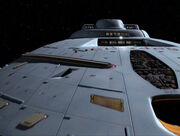
Close-up view of the Intrepid-class' primary hull
The hull configuration of the Intrepid class adopted the saucer-type shape of previous starship classes, that of primary hull, secondary hull, and nacelles driven by the physics of warp generation and control. One of Voyager's most notable characteristics are its retractable warp nacelles, a quality which has not been shown in any other starship. The Intrepid class uses a duranium hull structure, a plasma-based power distribution system, and tricyclic life-support systems. (VOY: "Drone")
Following the Starfleet standard, Deck 1 is reserved for the Main Bridge, with the briefing room and captain's ready room located to port and starboard sides of the bridge. Located in the front section of Deck 2 is the crew's mess hall, served by three windows that offer a spectacular view of space in front of the vessel. One deck below, located in the front section of Deck 3, are the quarters of the starship's commanding officer, served by five windows. Further down the primary hull is the diamond-shaped primary sensor array, immediately beneath which is the secondary navigational deflector dish. (citation needed • edit)
The dorsal saucer section is covered by four phaser arrays, two of which extend from the aft curvature, along the length of the saucer and stop short of the auxiliary deflector incision. The aft firing arc is covered by two smaller arrays, angled on the rear of the saucer section. The relative bottom of the ship is protected by two similar arrays as on the dorsal saucer section, extending to the rear of the saucer and following the curve to the auxiliary deflector incision. (citation needed • edit)
Docked to the underside of the Intrepid class' primary hull is the vessel's Aeroshuttle. This aerodynamic shuttle was the only upgraded component to the Intrepid-class starship that remained in the development cycle long after the other major systems had been frozen and released for fabrication and assembly. Based on the existing runabout platform, the Aeroshuttle was given a 450% increase in atmospheric flight and hoverendurance over standard shuttlecraft, accomplished through the use of hybrid microfusion and EM-driven airflow coil engines. Behind the aeroshuttle are two fan-shaped doors that lead up to a pair of cargo bays, airlocks, structural integrity field reinforcements, and a faceted hexagon with small flap doors in the center. (citation needed • edit)
The landing mechanism
An Intrepid-class Deflector emitting a graviton beam
Further aft, the main navigational deflector dish is found at the foreside of the Intrepid class' secondary hull. Located right above the deflector is the forward photon torpedo launcher. On the underside of the secondary hull are located three sets of plates that support the warp propulsion system. The forward plate covers the reserve intermix chamber; the middle plate contains the antimatter loading port, a large magnetic valve that keeps the antimatter from coming in contact with matter during the transfer to the storage pods; and the aft cover plate contains the operational intermix chamber hatch, for ejecting the warp core in case of emergency. (VOY: "Day of Honor")
Being one of the few Starfleet starship classes capable of atmospheric entry and planetary landing, the Intrepid-class starship is equipped with antigravity generators as well as impulse and lifters strategically placed at the mass and stress points on the bottom portion of the secondary hull. Prior to and during landing or takeoff procedures, the vessel typically goes to Blue Alert, indicating to the crew they are to assume their code-blue stations. (VOY: "The 37's")
Master Systems Display of an Intrepid-class starship
Command and control systems
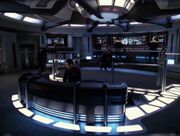
Intrepid-class main bridge
The Main Bridge of the Intrepid-class starship is ovoid and serves as the nerve center of the vessel. At the bridge's rear is a large bank of consoles and data readout screens. Center of that area is the Master Systems Display; control consoles flank it on both sides. (citation needed • edit)
Starboard of the information center, past the starboard side turbolift, is the station of the chief tactical officer. This area is maintained mostly for internal security and combat situations. Other systems that may be commanded by Tactical include long- and short-range sensor arrays, sensor probes, message buoys, and tractor beams. An identical station is found on the other side of the bridge, where the operations console is found. This panel presents the operations officer with a continually updated list of current major shipboard activities. This list permits Ops to set priorities and allocate resources among current operations. This is especially critical when two or more requests require the use of the same equipment, entail mutually exclusive mission profiles, or involve some unusual safety or tactical considerations. (citation needed • edit)
Section of the Intrepid-class Captain's Ready Room
Forward of the upper ship operations areas are doorways to the briefing room at one side and the captain's ready room at the other. Here, the commanding officer can engage in administrative work with all relevant office equipment at hand without interfering with bridge operations. Also, this room is usually the preferred place where the captain can hold private discussions and/or receive classified communications. Aboard the Intrepid-class starship, the work desk is the focal point of the ready room, located ahead of the main entrance door. A raised level in the forward section of the room features a small table, a curved couch, and a replicator. The wall behind the couch features three windows looking toward the bow of the vessel. Compared with the much larger Galaxy-class starship, the Intrepid-class curiously has a more spacious, luxurious ready room. (citation needed • edit)
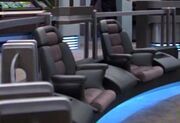
The chairs of the captain and first officer on the Intrepid-class bridge
In the center of the Intrepid class' bridge is the command area. Here, seating is provided for the vessel's commanding officer and his or her first officer, seated to the captain's left. Between these chairs is a miniaturized status display. Using keyboard or vocal commands, the commanding officer can use these controls to override the basic operation of the starship. Directly aft of this area, integrated in the handrail encircling the aft section of the central command area, is another command console that can be operated to perform more bridge duties. (citation needed • edit)
Directly forward of and two steps lower than the central command area is the Conn station. From here, the flight control officer serves as helmsman and navigator for the starship. Despite many of these functions being heavily automated, their critical nature demands a humanoid officer to oversee these operations at all times. During spaceflight at impulse, Conn must monitor relativistic effects as well as inertial damping system status. When the ship is traveling at warp speed, Conn must monitor the subspace field geometry in parallel with the Engineering department. During warp flight, the Conn console continually updates long-range sensor data and makes automatic course corrections to adjust for minor variations in the density of the interstellar medium. (citation needed • edit)
To the Conn's right sits the chief engineer. Though the position is far better served in Main Engineering, situations arise where the engineer's presence is needed on the bridge. The console allows complete control over all engineering systems. Directly opposite sits the chief science officer in a similar console. (VOY: "Caretaker")
Propulsion systems

The intermix chamber of an Intrepid-class starship
Main Engineering aboard an Intrepid-class starship is located on Deck 11. The room is constructed around the matter-antimatter reaction assembly (also known simply as warp core), featuring two levels. In front of the warp core is a large monitoring area on the lower engineering level. Also located on this level is the chief engineer's office and an open work area for special projects or situational analysis. A second tier rings the upper level of Main Engineering. A small, single-person elevator, as well as a ladder on the opposite side, provide access to this catwalk. (VOY: "Caretaker")
The main Impulse engines on an Intrepid-class starship are located on the aft end of the pylons leading to the warp nacelles. Intrepid-class starships are also equipped with auxiliary impulse reactors. (VOY: "Phage")
Warp core ejection
In the event of a warp core breach, the Intrepid-class starship can eject the warp core. This procedure requires the authorization code of the chief engineer or a member of the senior staff. The core is ejected through the ejection port on the underside of the secondary hull. Magnetic rails inside the channel accelerate the core once disengaged from the vessel and fire it away from the ship. Under normal circumstances, the vessel then moves away from the core as fast as possible under impulse power. (VOY: "Renaissance Man")
Should the core not go critical, the vessel can recover it with tractor beams and careful manipulation. (VOY: "Day of Honor")
Tactical systems
Phaser systems
An Intrepid-class starship firing its phasers
The Intrepid-class utilizes the Type-10 phaser array system. The dorsal saucer section is covered by four phaser arrays, two of which extend from the aft curvature, along the length of the saucer and stop short of the auxiliary deflector incision. The aft firing arc is covered by two smaller arrays, angled on the rear of the saucer section. The relative bottom of the ship is protected by two similar arrays as on the dorsal saucer section, extending to the rear of the saucer and following the curve to the auxiliary deflector incision. (citation needed • edit)
More protection is provided by an array that extends across the ventral engineering hull just fore of the warp core ejection port. Far-aft strips are provided on the underside of the mobile nacelle pylons and under the shuttlebay landing deck on the underside of the ship for a total ship's complement of 13 arrays. (citation needed • edit)
Torpedo systems
The Intrepid class houses five standard torpedo launchers (two fore, two aft, and one on the base of the engineering hull ), loaded with Type 6 Mark XXV photon torpedos, capable of pattern firing as well as independent launch. The Intrepid-class starship can carry a maximum of 55 torpedo casings. (citation needed • edit)
Deflector shields
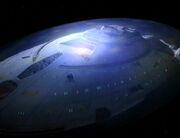
The Intrepid class' deflector shields react under incoming fire
The Intrepid class' deflector shield is a symmetrical, oscillating subspace graviton field. During combat, the shield sends data on what type of weapon is being used on it and what frequency and phase the weapon uses. Once the tactical officer analyzes these data, the shield can be configured to have the same frequency as the incoming weapon – but different nutation. This tactic dramatically increases shield efficiency. There are a total of 14 shield grids on the Intrepid class. (citation needed • edit)
Tractor beam
Each Intrepid-class tractor beam emitter is directly mounted to the primary members of the vessel's framework. The forward emitter is located on the underside of the secondary hull under the main Deflector dish. The second emitter is located at the aft end of the secondary hull in the aft section of Deck 14. (citation needed • edit)
Crew support systems
Medical facilities
There is one large sickbay facility located on Deck 5, equipped with an intensive-care unit (ICU), biohazard support, critical care, a morgue, the chief medical officer's office, a load-out of three standard biobeds and one surgical bed in the main ward, and a small medical laboratory. The standard medical staff consists of a doctor and a nurse, supplemented by the Emergency Medical Hologram, the Intrepid class being one of the first to be equipped with this new medical technology. (VOY: "Tuvix")
The intensive-care unit
Three biobeds line the walls of sickbay's ICU; these are for patients receiving medical care and are equipped with biofunction monitors. Located in the corner of the main ward is a surgical bed, where major surgeries are performed and critical patients are treated. A large, sophisticated sensor cluster is installed in the ceiling directly above this bed. Working ith a medical tricorder, the sensor suite can give detailed information about a patient's condition. The bed is also designed to use a surgical support frame. The small area that the surgical bed is located in can be isolated by a force field. If necessary, surgery could be conducted in the intensive care ward if there were an overflow of patients or if another patient is present to donate blood. (VOY: "Phage", "Latent Image")
Located in the center of the sickbay facility is the chief medical officer's office. Here, the CMO is provided with an area to work in privacy or conduct meetings with patients, staff, and others. Its proximity allows the CMO to be present in sickbay practically immediately. Located behind this office is a small medical laboratory facility. The medical staff or other associated personnel can monitor experiments or run tests here during ther duty shift. Just off the medical lab is located a tiny area for storage of the deceased. (VOY: "Macrocosm", "Basics, Part II")
Recreational facilities
There are two medium-sized holodecks aboard the ship. Located on Deck 6, these holodecks are proprietary Federation technology and can comfortably support up to 15 people at a time. The Intrepid class' holodecks were of a next generation of holographic technology, even further advanced than those applied on board Starfleet vessels during the 2360s, being able to impersonate matter even at the molecular level. (VOY: "Phage")
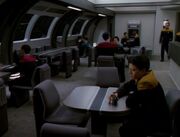
Crew mess hall on board an Intrepid-class vessel
On the Intrepid-class vessels, the mess hall is on Deck 2, Section 13. Some ships were equipped with four food replicators, with a private captain's dining room just behind the mess hall. This dining room could be reconfigured to serve as a kitchen, as done by Neelix aboard the USS Voyager. The USS Bellerophon's mess hall was also fitted in this manner. (VOY: "Phage"; DS9: "Inter Arma Enim Silent Leges")
The mess hall is usually host to many social gatherings, including diplomatic affairs, birthday parties, and holiday celebrations. The mess hall can also serve as a makeshift sickbay whenever that facility is disabled or otherwise overwhelmed. (VOY: "Someone to Watch Over Me", "Latent Image", "Macrocosm", "Homestead", "Before and After", and more)
A crew's lounge is located in the far aft section of the vessel's secondary hull, providing a view of space aft of the Intrepid-class starship. (citation needed • edit)
The Intrepid-class also has a gymnasium. (VOY: "Eye of the Needle")
Crew accommodations
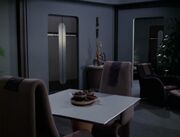
Officers' quarters on board an Intrepid-class starship
All crew and officers' quarters (except the captain's quarters on Deck 3) are located on decks 2, 4, 8, 9, and 13, with special variable environment quarters on Deck 11 for crew with special comforts. Although the Intrepid class is highly advanced, the quarters in general are smaller than those of other vessel classes because of its smaller dimensions. (citation needed • edit)
There are several types of crew quarters aboard:
- Standard crew quarters:
- These small quarters units are located within the primary hull and lack windows. They include a living area, a bedroom, and a bathroom. Crewmembers of lieutenant junior grade are given their own quarters; ensigns and crewmen are required to share their quarters (except for senior officers; Ensign Kim had his own quarters). The living area contains a replicator terminal and is customizable with a variety of furniture and decorations. (VOY: "Good Shepherd")
- Officers' quarters
- These quarters line the edge of the saucer section and contain a living area, a bedroom, and a bathroom area. They are generally reserved for those of ranking lieutenant or higher. Members of the senior staff are typically assigned quarters featuring a pair of larger, wider windows. (citation needed • edit)
- Captain's quarters
- The captain's quarters, located on Deck 3, are similar to the officers' quarters but are slightly larger. The captain has a large desk area and work terminal. His or her quarters feature five windows (below the Navigation Lamp), which offer an excellent view of space in front of the vessel; the captain's quarters are positioned below the mess hall. (citation needed • edit)
Transporter systems
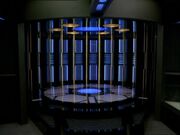
Intrepid class transporter room
The Intrepid class' transporter facilities are located on Deck 4. In case of emergencies, injured personnel can be directly transported to sickbay from anywhere in transporter range, including inside the ship. (citation needed • edit)
Auxilary spacecraft systems
Interior of shuttlebay
Overview of shuttlebay
Located in the aft dorsal portion of the secondary hull, the main shuttlebay is the primary port for entrance and egress, as well as management of auxiliary craft and shuttles. The main shuttlebay is managed by a team of pilots, engineers and technicians, and operations personnel that are based on the flight operations office under the supervision of the flight control officer. (citation needed • edit)
Inward from the main shuttlebay is a secondary storage/maintenance area behind huge inner airlock doors. This secondary area is almost as large as the main shuttlebay and is commonly referred to as Shuttlebay 2. (citation needed • edit)
The Intrepid-class starship is typically equipped with the following types of shuttlecraft:
- Type-6 shuttlecraft
- Type-8 shuttlecraft
- Type-9 shuttlecraft
The crew of the USS Voyager, stranded in the Delta Quadrant, constructed the Delta Flyer for more complex auxiliary spacecraft operations. The craft was in operation since early 2375. (citation needed • edit)
- The Intrepid class was also equipped with an Aeroshuttle, which is visible on the underside. However, this vessel was never seen used on screen.
Ships commissioned
- USS Bellerophon (NCC-74705)
- USS Intrepid (NCC-74600)
- USS Voyager (NCC-74656)
Appendices
Appearances
Apocryphal Appearances
- The Intrepid-class starship is featured in Activision's Star Trek: Armada II and Star Trek: Starfleet Command III, while the USS Voyager appeared in Star Trek: Voyager - Elite Force and Star Trek: Elite Force II.
Background information

Concept art for the opening credits of Star Trek: Voyager
The earliest concepts for Star Trek: Voyager came in September 1993, during the last season of The Next Generation and the second season of Deep Space Nine. Star Trek producers had already begun to plan for a new series set on a smaller starship than the Enterprise-D, but instead of waiting for more clarification, Rick Sternbach immediately started making sketches of this unnamed vessel.
Sternbach's early sketches had Voyager as a streamlined, dartlike primary hull, with a flattened, elongated engineering hull, sporting swept-back runabout-like warp pylons. Later on, it was decided that Voyager would be able to land on a planetary surface, requiring deployable landing gear and other arrangements of resting-on-hull components to be sketched out. Variations filled more paper as the proportions of different parts changed, pieces were added and subtracted, and hull contours, both gently curved and angular, were explored in perspective. Even in the rough sketches, a lot of design ideas got worked out, concerning placement of familiar items like impulse engines and phasers. Not surprisingly, this exercise would be repeated in greater detail with each new approved version of the hull. Preliminary hull cross-sections were drawn in blue pencil to check different internal deck heights, total number of decks, and possibly overall ship length.
During April and May of 1994, the first real sense of the new starship emerged. The slightly angular dart front was smoothed off and nestled into the engineering sections, still assuming a separation capability, and sweeping pylons ended in a set of long nacelles. Doors on the nacelles could open, exposing the warp coils for some new kind of energy jump. Impulse thrusters were buried underneath, as in the runabout, and a large triangular wedge sat atop the ship, possibly acting as a scout craft or long-range sensor array. In this design, all of the familiar Starfleet parts were added, in type and location, much the way they eventually were. A few cut-and-paste variations were assembled, along with a sleeker version that left out the long-range sensor pod and combined a few shape ideas from the runabout and the Excelsior class. Here, a few more details crept in, notably the large forward sensor cutout, and a stepped engineering hull that supported a ring of large cargo bays and impulse engines. This particular variant received additional approval from the producers and proceeded to the initial blueprint and study model stages. Sternbach scaled up a top plan view sketch of the ship to a length of 48 inches – the presumed size of the motion control model at the time. From the top view, Sternbach derived bottom, side, fore, and aft views. The side elevation (and resulting cross-section) showed 14 decks, and that the ship was about 1,000 feet long (the same size as the upgraded Enterprise from The Motion Picture).
Close-up view of the primary hull, showing escape pod hatches, sensor panels, a phaser strip and crew quarter windows
There seemed to be no insurmountable problems from the design standpoint in giving it all the proper fictional starship systems, or of building and filming the miniature. The set designs could be matched in shape and color. This version of Voyager looked fast, with a hint of solid engine hardware showing on the outside. Just as Sternbach was about to produce a final set of modelmaker's blueprints, the producers asked if he could make Voyager a bit more blended, more curvy; just as a physical model of the USS Voyager had been completed, the producers called for softening the hull contours. Sternbach also still worked on the nacelle placement, mounting them on pylons like on the Enterprise-D, or downturned like on a runabout, and horizontal pylons that evolved into wings.
Following the Starfleet standard, Sternbach reserved spaces for the bridge on Deck 1 and a variety of placeholder windows on the hull, which would be built into standing sets. Windows are an important design factor because of the coordination necessary between various studio departments and an outside modelmaker over continuity of the exterior of the ship and the interior. Since Voyager would be smaller, structures like windows would be proportionately larger and more visible, requiring more model details matching the stage sets. The large windows that appear on the upper side of the Voyager model were designed by Rick Sternbach to accommodate the living quarters of the starship's senior officers, the five windows located underneath the officers' mess on the forside of the ship being allocated to the captain's quarters. For all quarters, the same set was used on the show with removable wall segments being used to make it either a two-, three-, or four-window quarter (presumably the fifth window of the captain's quarters serviced its bathroom).
The Voyager prototype
The Voyager study model
The "Voyager Prototype" was a study model designed by Rick Sternbach during the pre-production of Star Trek: Voyager. This was a mock-up only, it was not built as a filming miniature. Featuring many details that would make it into the producer's final choice for the design of the Intrepid-class USS Voyager, this prototype featured sharper, more angular shapes, and long, downswept warp nacelles mounted on pylons designed similarly to those on the Danube-class runabout. This is very similar to the kitbashed filming model that was labeled USS Elkins, leading to those two models to be sometimes confused.
Non-canonically, this design has been referenced by the Last Unicorn Games' role playing game books; they assign the name of the Bradbury-class to this ship, although this bears no regard for the producers' and creator's intentions. The Voyager's registry number on original plans was NCC-73264, but this was changed before the study model was built.
Designing the bridge
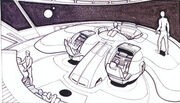
A Jim Martin concept art for the Intrepid-class' bridge
After six years as production designer on The Next Generation, Richard James was no stranger to the legacy of Star Trek and the production requirements of episodic television. When given the assignment to create a new starship from the inside out, he had to start up from scratch. Nothing had yet been established, and thus for his first meeting with Star Trek: Voyager' creators and producers, James decided to push the boundaries of everything that had gone before. Early concept sketches show bridge designs without the large viewscreen in the front of the bridge and command functions decentralized, obviously breaking the traditional bridge mold.
However, by exhaustively reexamining the dramatic requirements and technological underpinnings of the Star Trek bridge without preconceptions, James rediscovered the strengths of the basic template laid out by Matt Jefferies almost thirty years earlier. But with the broad strokes of the bridge's layout firmly embedded in Star Trek's past, James and his team went on to bring a fresh new interpretation to the heart of every Star Trek adventure, investing it with a sleek, efficient, and welcoming appearance that made Voyager something of its own – the Star Trek for the nineties and beyond.
Sources
- The Art of Star Trek, Judith and Garfield Reeves-Stevens, Pocket Books, 1997.
- "Designing the U.S.S. Voyager", Star Trek: The Magazine, November 2000, issue 19 and July 2001, issue 28.
- I nterview with designer Rick Sternbach at Forgotten Trek, July/August 2005.
Footnotes
- Some of the information in this article is adapted from Rick Sternbach's guide to the development of the class from Star Trek: The Magazine Vol 3, Issue 1, under the Starfleet Technical Database banner.
- The Voyager's MSD is from the Star Trek: The Next Generation Sketchbook: The Movies.
- Although the writers of Voyager insisted on trotting out the 9.975 cruising speed figure in dialog once every season or two, this was never borne out in any episode. In The Swarm, there was some question as to whether or not the ship could hold warp 9.975 for the twelve hours necessary to cross a region of alien controlled space. At no time in the series did we see the ship go faster. Actual observed performance would suggest a cruising speed of warp 9.75 (though that might also be the twelve hour maximum) and an emergency speed of 9.975 for ten minutes, rather like the 9.8 speed as attained by an original Galaxy-class starship.
- A dedicated count of the hull indicates the presence of fifteen phaser arrays on the Intrepid-class rather than the thirteen featured in this article. At the same time, based on observation of the series Star Trek: Voyager, it seems unlikely that the class is equipped with Type-10 phasers. On-screen, the Intrepid-class phasers never appear to pack the wallop of those fired by the Enterprise-D throughout Star Trek: The Next Generation.
